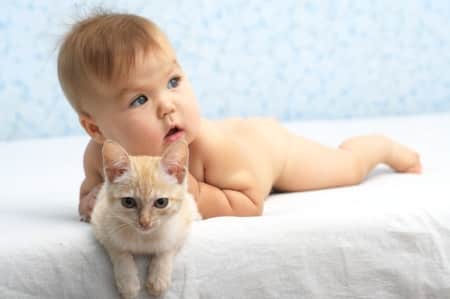I have provided you with some practical advice in the entry Dog, Cat and Pregnancy, which you should read right away. But in this entry, I want to provide you with information that will ease mom’s return home with the baby. Once again, I will start with canines and then continue with felines given that the questions and advice are different for each. All of this information can be added to what you learned during prenatal classes, which do not go into the fine details of this issue.
Quelques trucs pratiques vous sont suggérés dans le billet Chien, chat et grossesse, que je vous invite à consulter dès maintenant, mais je vous donne spécifiquement, dans ce billet-ci, les informations permettant de faciliter le retour à la maison de la nouvelle maman avec son bébé. Encore une fois, je commencerai par les canins, puis poursuivrai en parlant des félins puisque les trucs étant différents, cela répondra plus précisément à vos demandes respectives. Toutes ces informations s’ajouteront aux connaissances apprises lors vos cours prénataux qui ne couvrent pas dans les fins détails toute cette dimension.
The return home can take place before you go and pick up your dog where they were kept during hospitalisation. When you arrive with your newborn, take them into each room so that their smell is everywhere for when you bring your dog home. Additionally, when the dog enters the home they will see the baby as an additional member of the pack as they are already there. You should also let them smell the baby, but only if it is calm and not crying or agitated. A crying baby can have a major impact on the dog and lead to fears and other undesirable reactions.
You should also never leave the baby alone with the dog, even if the dog has always been calm and has a good temperament. Take nothing for granted – an animal is still an animal! If it is surprised, you never know how they will react.
As much as possible you should always try to respect your dog’s routine. For example, walk the dog alone for two months before taking them out with the stroller, which will help with the integration of the baby in the dog’s everyday life.
If your dog growls or is excited, explosive, or dangerous for you or other people, you should always go and see a canine specialist to get their opinion on the situation to avoid unfortunate events from happening. If your dog is considered to be a real threat to your child, it is better to have it adopted by another family that doesn’t have children, where they will be happier, and it will keep your family safe.
An animal remains an animal that you should not have blind trust in it, even if you love it a lot and they have never been aggressive.
Cats have very different reactions. In contrast to dogs, certain cat species can have more difficulty than others in adapting, especially for Siamese.
On returning home, it is a good idea to give your cat a treat – tuna, favorite snack – to make the baby’s arrival a party, as this will reduce the cat’s anxiety. You can allow them to enter the baby’s room as long as you stay with it and the baby is there. Also take note that an anxious cat can urinate outside their litter box. If it continues over time, there are anxiolytics for cats that can calm them and better transition to the new situation.
As a general rule, the cat will want to play with the baby. But the sudden movements by the baby can create stress for the cat if they are surprised. As a reflex they might want to defend themselves, scratch or bite them. This is why parents must always be vigilant. If your kitty behaves surprisingly or in a different way, you should consult a specialist to ensure a safe home.
In conclusion, I would say that an animal remains an animal and you should never fully trust it, even if you love it a lot and they have never been aggressive. Additionally, parent’s need to quickly teach the baby to respect the animal and show them that they are not a “stuffed toy” that they can do what they want with. I hope this entry has provided you with answers to your specific questions about the return home with your baby and as additional information for your prenatal preparations.
Here are a few videos that can help you on this subject:
- Les animaux domestiques et grossesse
- Bonnes habitudes de vie et grossesse
- Papa et grossesse
- Préparer votre séjour à l’hôpital
- Adaptation au retour à la maison
Other interesting entries with information about this topic for pre or postnatal:
- Soins au bébé en postnatal
- Bientôt, je serai papa
- Adaptation à l’arrivée d’un bébé
- Bientôt un nouveau bébé
Talk soon parents!
Marie
The Baby Specialist
Please share your experiences in the comment section.


